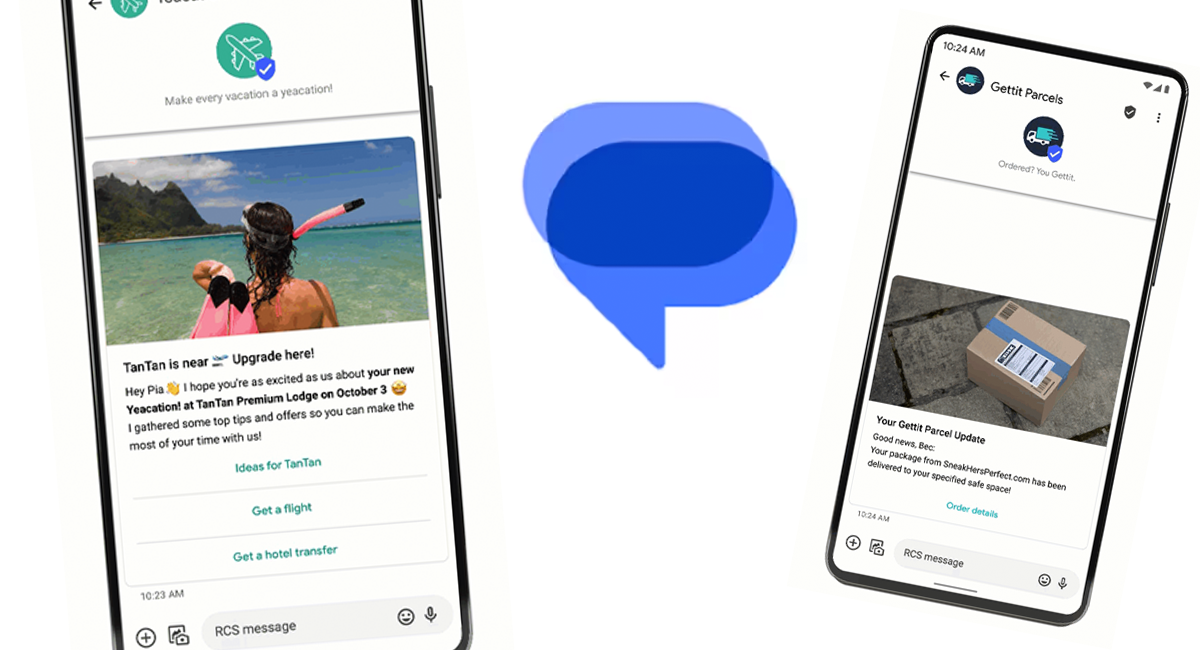When the telecom carriers took on the gargantuan task of self-regulating long code (10DLC) messaging in response to the growing swell of spam, one of their first moves was to create The Campaign Registry (TCR). But what exactly is TCR’s role—how do they support the carriers, and what benefits do they offer to service providers and the brands working to send messaging campaigns?

Brandon Ramirez, The Campaign Registry
Watch now as Brandon Ramirez, head of Customer Success at TCR and this month’s Telecom Wise Guy, answers these questions and more. He provides some helpful background and answer the questions customers ask our support team every day, such as:
- How does a company without an EIN, such as a sole proprietor, register their brand?
- How should an agency register a client’s brand—and what if another agency has already registered the client?
- Based on their observations, what are some of the things that matter most to the DCAs when reviewing and/or rejecting campaigns?
- Approval can be revoked at a later date—what are the big reasons why this can happen, and what can senders do to stay in compliance long term?
- How can you raise your brand’s message throughput?
- What are the top three tips they’d give messaging providers and, conversely, what would they tell customers to look for in a provider?
- What changes do you predict in 2024?
Listen now for all the tips and tricks to help ensure your long code campaign success!
Webinar Transcript
Tim: Well, good afternoon, everybody and welcome to yet another Telecom Wise Guys webinar from your friends here at Commio. Really excited, I feel like this webinar has been a long time coming. We’ve got Brandon Ramirez here from the Campaign Registry. Brandon, thanks for making the time.
Brandon: Of course. Happy to be here.
Tim: Yeah, we had a webinar last month talking about all things 10DLC as well as toll-free and short code. And I think we spent a lot more times on the questions for you all than we did on, I think the master concept, which is not surprising. I think there’s still a lot of people out there that have have questions. And that’s partially why we’ve invited everybody in today to ask questions of you, Brandon. I know you don’t have all the answers. Hopefully you have some. That’s all we ask.
Brandon: I’ll do what I can.
Tim: Really appreciate your time. And I will reiterate to, I think here at Commio this is actually a couple of days away from my fifth anniversary here at Commio, and I go back to the days where we had folks who were customers of ours who were basically putting application to person messaging, message campaigns over person-to-person rails back up at the carrier layer. So I guess Brandon, we would love to know a little bit of the history. Where the campaign registry came from and what do we what do we use it for? What do we need it for?
Brandon: Yeah, well, it’s actually funny that you mentioned you’re coming up on your five-year anniversary; I had my five-year anniversary with the campaign registry as well in October. So that said, we’ve been around for about five years now. We weren’t fully being utilized for the first little bit of development time and kind of building up the concept and TCR what it is. But in terms of actual registration and being fully in market, being adopted by the carriers, it’s been about three years now that we’ve been doing this and we came about basically like you said, it was previously A2P or businesses were using long codes and codes that were material for P2P, for person to person communication as an unsanctioned business channel, which was never what it was intended for.
And it was kind of a Wild West. No one knew what was going on. The carriers didn’t know what was going on. It was just that you can send whatever you can by a bunch of numbers and whatever you wanted. So we came about as a proposed solution to help fix this. You know, we proposed our solution. Carriers liked what they saw and worked with us, and they all signed on to have us be kind of the de facto registration point for 10DLC messaging, right? So once 10DLC was created, the official 10DLC channel for the sanctioned business messaging on long code, the carriers then decided to adopt TCR, work with us to develop the product and now if you want to have access to 10DLC, you need to register, which is a good thing. Obviously there is a big learning curve for a lot of people who never had to do any registration before, but it is a good thing. It brings clarity. People know basically the registration, we recollect who you are and what you intend on doing. So everyone in the chain, not just carriers, but you guys, everyone in the chain knows, “Cool, here’s where the messages are coming from. Here’s what they intend on sending. Because of that, we’ll give you access to this better business messaging channel, this approved sanctioned business messaging channel of 10DLC. So that’s kind of the brief history of TCR, how we came about and where we are right now.
Tim: That’s right. And it’s like I said too, it reminds me a lot of when STIR/SHAKEN popped up on the voice side of things where, unfortunately the FCC had to step in to get the carriers to do what they needed to do. And it gave a chain of custody for a phone number from beginning to end so we could actually figure out who was in the ecosystem delivering these calls, and we knew who to go to if there were any issues. And feels like TCR is basically trying to do the same kind of thing for messaging for one type, right? 10DLC. So makes perfect sense. And I think we all agree that in this ecosystem that the more we can have chain of custody, the better at holding each other accountable.
And let’s see, we already have good questions coming in: Jeff, thanks for that. We’ll get to that when we get after the slides. But like I said, everybody use the Q&A button and we will get to those as we get a little farther along. So if we start with registering the brand, I know Brandon, there’s been some confusion about some of the steps of registering your brand. And I know part of it was, some folks coming in and wanting to do a brand registration don’t have an EIN number. So when does that pop up and what can people do about that?
Brandon: Yeah, so TCR, we do have a option for what we call sole proprietors. We realize that, if you take a look at the numbers I would say arguably a much larger portion of businesses, especially in the US, are small businesses or sole proprietors. There are tons of people that, you know, I might do paintings and sell them out of my apartment and I file all my taxes under my SSN, I don’t have an actual registered business, right? And that’s totally fin. We account for that, we allow for sole proprietor registrations.
Now, that said, it is a different process. It’s not the normal standard brand registration process. There’s not a lot of validation that we can do on a sole proprietor like we would do under normal business, where we verify the EIN, we check the legal name, all that kind of stuff, we can actually verify that “Yeah, this is that business.” With sole proprietor we can’t necessarily do that because we’re not capturing SSN’s, we’re not doing any of that verification. So we implemented, you know, there’s a one-time pin code verification that’s needed. There’s additional work that is needed to be done by each service provider or CSP that wants to support sole proprietor registrations for their customers. There is additional work that needs to be done by them because of this, not every CSP out there wants to support sole proprietors and that’s totally their prerogative to do so. A lot of them do, a lot of them don’t as well. So we do offer the ability to do that. It just depends on each provider, whether they want to support that on there.
Tim: Yes. So if your sole proprietor trying to work with somebody like Commio, you need to work with your provider on making sure that that is supported. Making sure that can be done. Makes sense. And then let’s talk about agency versus brand, because I know that, again, we’ve got brands who go to an agency and then they ask the agency to register them. And in some cases, that agency actually registers themselves as the brand. Right? And I think people get confused and you want to avoid that.
Brandon: Yeah. That’s a fair point. I mean, we see that actually quite a bit. I get asked that a lot. And the answer is, I mean by definition within the TCR ecosystem, the brand is who the end user believes they’re communicating with, that’s who should be the brand, right? So if it’s Pizza Hut and they’re working with one of these agencies to send their messaging, it’s not the agency that is communicating with a brand. It’s Pizza Hut. The consumer believes they’re communicating with Pizza Hut. Therefore, Pizza Hut needs to be registered as a brand.
So these agencies that support a lot of brands, maybe they support a lot of small businesses and they want to kind of just register themselves as the brand, it’s not the correct path. It really should be who’s actually communicating with the customer. So really, in that case, each individual business should be registered as a brand with its own campaign versus the agency registered as the overarching brand and kind of lumping everyone together. That’s not how it should be done.
Tim: Got it. So, Brandon, I know that usually there’s two ways to register with you all. Somebody like Pizza Hut, for instance, could go directly to thecampaignregistry.com and register themselves as a brand, right? And then when they find a provider, they can work with that provider.
Brandon: So actually a quick correction on that one. The Campaign Registry doesn’t actually work directly with individual brands or businesses. So Pizza Hut could not come directly to us and sign up and register directly with us. We work with the campaign service providers or CSPs like Commio. Who are responsible for then registering their customers into TCR. So an individual business cannot come and sign up with us directly.
Tim: Gotcha. That’s right. So you got to have both ends to be able to make the registration. Makes sense. I guess I was getting confused because we offer APIs and we have a platform as well where you can go and register. So there’s sort of three ways to get the job done, but you have to have the provider in play. Makes sense.
Brandon: Exactly. You ultimately as an individual business, Pizza Hut, Brandon’s Paintings or whatever it is, you need to register through a provider.
Tim: That’s right. You got it. All right. And here’s a good question here for when it comes to registering campaigns beyond the brand, what are the DCAs looking for when it comes to the campaign registration?
Brandon: Yeah. I mean, the simple high-level answer is clarity. They want to know everything that’s going on. And in the sense of registration, ambiguity is never going to be your friend. Vagueness is going to hurt you. You want to be clear. You want to paint a picture. So when registering a campaign, I would say, in my opinion, the most important fields where you can be descriptive is the call to action or message flow field, where you describe how a user opts in. Be very thorough, “Users opt in by going to this website and checking a form. They can also do it verbally over the phone.” You describing all the ways that a user can opt in is very, very important.
Additionally, the campaign description field, if you were to register, let’s say an account notifications campaign and the description was ‘We send account notifications’ doesn’t really tell you what’s actually happening, right? So that would be a very vague answer. So that fields a free-form field, it supports a lot of characters, putting like, ‘Hey, we’re a doctor’s office, we send appointment confirmations, we send appointment reminders. We also send things like doctor availability from wait lists or whatever’. Just paint a picture and clearly describe what’s happening on this campaign: What’s it used for? Because when, not only if people are registering via your front-end solution, or your connectivity partner chain, or anyone in the chain that’s doing the reviews, they want to be able to look at it and go, “Hey, I understand exactly what’s going on here.” If there’s any vagueness or any of that of you are like, I don’t understand this. Guess what? They’re most likely going to reject it for not enough information.
Something else that the DCAs are looking for a lot right now, which everyone either listening in on the call or you guys yourself, Tim, things like the terms and conditions and privacy policy. That’s a great kind of a hot topic right now. I can’t go too much into that because we’re not a compliance house so I can’t comment on why those things are needed. But I would say anyone that wants to do messaging, regardless of the channel, toll-free, 10DLC, shortcode, you need to follow the best messaging principles and best practices as set out by CTIA. That guide covers all of it. It applies to all messaging channels, so terms and conditions, that’s part of it. It wasn’t needed before a long code when it was just sending on the unsanctioned P2P channel. That’s why people never really did it. If you are coming from the shortcode and you were using shortcode before and you’re now switching to 10DLC, you know all about it, you know why it’s needed. But people that are new to 10DLC or maybe didn’t have to do it before, now all of a sudden they have to do it, it’s a learning curve, but those are the things currently that DCA are most looking for.
So without going too much more into the terms and conditions and privacy policy, because I can’t. But I’d say from TCR perspective, selecting the correct use case and being descriptive, it goes a long way in getting things approved the first time.
Tim: Yeah, I think you’d agree, Brandon, that you want to go through the registration process after you’re very clear on obviously who the brand is, you have all their information and the campaign, you know what the sample messages are going to be. You know what the use case is going to be. You have all those descriptors in place. You don’t want to rush and do this too early in the process. Right? You want to wait until you’re ready to get started.
Brandon: Yeah. Exactly
Tim: Gotcha. Yeah, we have people that unfortunately rush in and then they get multiple bounce backs and then they wonder what happened, and if they had taken a breath and they had sort of worked with our experts through the process, it could have been one and done. But I think some people are sometimes on the technical side and they just see it as a roadblock to getting a campaign launched, and that’s not really the best way to think of it. It’s really more about, when you’re ready to register yourself in the phone book, for instance, or a really formal place that really matters: Getting your passport, you got to have all the right information. It’s kind of the same idea.
Brandon: Exactly.
Tim: Don’t rush it. And also, this is the question we get a lot—by the way, have some great questions that have come in—Jeff, James, Adam, thank you. We’ll get to your questions in just a moment. But this question comes up a lot is: We register the brand, we register the campaign. What about our throughput? How can we either increase it or from the beginning guarantee good throughput for our messaging?
Brandon: Yeah. So that’s a great question, we get asked a lot. So quick overview of the process: When a brand is created and verified—you have to be a verified brand in order to start registering campaigns—every verified brand gets access to the entry level of throughput for both AT&T and T-Mobile. That’s the starting point. If you’re okay with that, go ahead. If that’s sufficient for you, create your campaigns. You’re off to the races.
If it’s not sufficient for you or if you grow over time, the best way to get your throughput increased is to apply for an external. So we have third party vetting organizations, that’s Aegis Mobile and WMC Global. You can use either of those, they’re fully integrated with us, you can order through our platform. Some service providers have direct relationships with Aegis or WMC from previously, so they can order directly and import the vetting. But vetting is the first starting point to increase your throughput. So when a vet is done, they check a lot of things about the business, length of time of business, history, number of people that work in the business, any previous TCPA violations or messaging lawsuits, they do a big deep check on the brand and come back with a score from 0 to 100. And that score, depending on where it is, puts you into the appropriate service level with the carriers.
Hopefully it goes up. Sometimes it may stay the same depending on if there have been major issues before, it could keep you in that lower tier. But that’s step one to do that. And if that fails, there’s measures after they can do. But step one is if you need to increase your throughput, apply for vetting and that will hopefully yield you a sufficient throughput level.
Tim: Got it. Makes a lot of sense. All right. And I actually see a few of the questions are related to this. But even after somebody has registered a brand and a campaign, they’ve been sending messages over time, those messages tend to drift in terms of content. So can you give people guidance on a you know, at one point this campaign was registered and running successfully. Maybe now it’s not running or it’s not in compliance anymore. How do you sort of deal with sort of a campaign that’s shifting over time?
Brandon: Let me start by saying, the use case of the campaign. So step one whenever you’re registering a campaign you select the use case. We have a bunch of different use cases that are kind of, they should encompass the majority of messaging needs. But once you select the use case, that is not editable. So let’s say you register a 2FA campaign, right? And over time, you want to maybe incorporate promo codes as well, or coupons, right? Marketing type stuff into that as well. Guess what? You can’t do it on that campaign. You need to register a new campaign that may be something that offers both 2FA and marketing. We have these mixed use case campaigns where you can do up to five kind of sub-use cases on that one campaign. So step one is selecting the right use case. And if your campaign drifts over time, you want to start adding more stuff. Set up a new campaign. Sounds like the old one. Move your numbers over and then you can continue to go with the new content.
So typically campaigns stop because they’re suspended. We don’t see traffic. We’re not monitoring whether campaigns are continuing to do what they say they are doing. We’re not the ones making decisions on deactivating a campaign or anything like that. Typically, campaigns get suspended if there’s been multiple complaints on the traffic from consumers or if people discover that, “Hey, you said you were doing customer support only and now you’re primarily exclusively doing marketing and sending links to promo codes and stuff, which is not what you said you were doing.” So that’s typically why campaigns get suspended.
Now we do allow within a campaign, we understand that there’s traffic drift and things evolve over time, and so we do allow certain attributes of the campaigns to be editable. So, for example, let’s say you registered a mixed-use case campaign, right? And you selected marketing, customer support, and 2FA as the sub-use cases, right? And you’re marketing traffic, it’s still there but for the customer support, it may vary a little bit. So now you can actually edit the campaign description, say, “Hey, it’s evolved to customer support is now also included in kind of this area,” you can actually update the details of the campaign, especially the campaign description to make sure that it’s still compliant and everyone knows what’s still going on with that campaign. So if something does happen. They can go back and refer and say, “Oh, yeah, it was updated on this date, this is now there. You’re good to go.”
So the one thing is, like I said, if the use case completely changes, the best bet is to register a new campaign that includes that. Sunset the old one. Or if you want to keep them two separate ones, that’s totally fine as well. But the use case is something that will not be editable ever. The campaign attributes and descriptions? Yes, those can be edited, but the actual use case itself, that’s something that cannot change.
Tim: Got it. All right. Makes sense. And we were going to ask you, Brandon, directly. You know, we have a little drum roll in here, what are your top three tips for providers themselves in terms of brand and campaign registration. And when we’re out here talking to folks that are looking for a partner to help them with this, you know, what should folks that are getting into messaging look for in a provider?
Brandon: Yeah, that’s a great question. We actually get that a lot, too. So I’m sure you guys know, I know, everyone on the call probably has seen it, there’s a lot of misinformation out there. People take information, they kind of interpret it their own way and disseminate that down the chain. So I would say the top three things for providers are make sure that you’re always up to date with with TCR News, TCR updates that you can then educate your own customers down the chain to make sure that things are done correctly. There’s a lot of people out there that create a front-end solution. They don’t they don’t teach their customers how to use it. They just say, you have to register. Well, what does that mean? It means you have to register. There’s no additional help or support or anything like that.
So when brands ask, obviously we have to remain impartial on being the registry, we can’t promote one provider over another, but we always say, “Look for someone that offers support and especially at the beginning will hold your hand and guide you through the registration process. Because for people that are new to this, even people that have been doing this for a long time, this whole 10DLC and whole registration point: yes, it’s been around for three years, it’s still relatively new, right? It’s still fairly new process. So being able to really educate the brands that are needing to register, educate them why this needs to happen, what the process is, what the information’s needed so that when they go to register, like we talked about earlier, you know, don’t register until you’re ready.
Make sure that you as a provider, make sure that you’re educating your customer. And make sure they know all the information that is needed and why it’s needed so that when they go to register, it’s a smooth and seamless process and they understand why they’re doing it. So I’d say if a provider says, “Hey, what can I do better?”
Education is key. And in my opinion, education is key. That’s why we’re helping join these webinars and we are putting out new guides in education from TCR that CSPs can then use and share down the chain and stuff like that. So educate them. If I could do top three tips, it’s education, education, education. That would be my stance, obviously customer support or customer care. Education is my main thing. So any provider that helps TCR spread this information and really holds your customers hands, especially in the beginning, that’s the provider you want to look for. And as a provider, if you can do that, you know all power to you. I support that fully, but that would be the biggest thing; is education and really help your customers understand why this is happening and why this is needed.
Tim: Got it. Yeah, that’s one thing we’ve invested in a lot of here in Commio is having the right people in the account management team when new campaigns start to make sure that you can get everything registered properly and increase your throughput, keep it high. So I totally agree. And that’s why we’re on this webinar today, right? It’s all about keeping folks educated about what’s going on because we do change. And speaking of change, before we get to your questions, everybody, thanks for hanging on. As we look ahead to 2024, kind of what are the near-term changes do you see coming from the TCR side of the fence?
Brandon: So coming into the end of this year and I’d say maybe the first quarter of next year, we’re adding some new functionality to make things a little bit easier. Things like migration capabilities where a CSP can migrate their campaigns. Maybe you work with an upstream provider and you want to move to someone else, we’re going to be able to shift those commands. Right now, you kind of have to reregister all those campaigns with the provider. We’re going to be able to migrate those, which is great. That’s kind of the big thing we’re working on right now.
But the main goal for 2024 is, try not to change things too much, or implement big changes. From a TCR perspective, like I said, we’ve been around for three years. We’ve been doing this, yes. There’s been a lot of changes, as you know, the growing pains and things that we thought were covered that maybe weren’t and other things, other people, DCAs, CSPs, brands, carriers, everyone pointed out, “Hey, we didn’t solve for this. We need to solve for this.” Which is why we’ve obviously had a lot of major changes over the last three years. But I think now coming to 2024, the dust has kind of settled on a lot of the major changes.
There might be some, we still might uncover things that we haven’t thought about which require change. But in my opinion, 2024 is really going to be focused on upgrades, you know, process improvements, ease of use, better functionality, just things that to improve the registration process and improve kind of quality of life for using TCR versus, “Hey, guess what,now you have do this completely differently.” Which was the case previously. So that’s our main goal. Like I said, I can’t say that changes won’t happen, but I think the majority of major things have kind of worked themselves out now. And now it’s working on improving and getting things more streamlined.
Tim: Got it. All right, great. Well, Brandon let’s go ahead and dive into the questions. We’ve got quite a few here, so we’ll start with Adam’s questions. Adam asked: How do you register a business that has multiple locations but doesn’t share a common name? For instance, a franchise where the name of each location is different. This is common in property management and the automotive sectors.
Brandon: Yeah, so that’s a great question. Actually was just talking to someone else about this yesterday. So it kind of depends on how the business is set up. So let’s say it’s ABC Mechanics, that is the overarching company. They have ABC Mechanics of, I mean some Vancouver names or some Canadians, ABC in Vancouver and then they have, ABC of Los Angeles or whatever. Right? They have different locations. The names change slightly, but overall they kind of are all rolled up into the same business and they all share the same EIN. In that case, it really depends on how they want to be separated. So what you could do is register ABC Automotive or whatever I said as the overarching brand with the EIN, and then you can register separate campaigns for each location that they have. That’s one option.
We don’t limit, we allow brands to register multiple times using the same legal name and EIN. There’s no limit on how many times a brand can register. So you could register your ABC Automotive, this with DBA, Brandon’s Automotive over here. You can register it again with the same legal name and EIN with another DBA name for the other location, and you can do it that way as well. So it kind of depends how as the provider or whatever, how they want the separation to be. Some people like to really have individual registrations per, that’s just how they like it to be done. I’ve seen property management companies where they’re like, “Hey, we want to have a separate registration for each building that we manage. It’s all under our property management thing, Brandon’s property management group. But I want to have a separate brand registered with each DBA with the building name or whatever. However, I separate it from my own, my own knowledge, and my own records.”.
I’ve seen other ones that say, “Hey, I just want to do this and register a separate campaign for each one. So there’s a couple of ways to do it. Like I said, you can register the same brand multiple times using the same EIN and just change the DBA name for each one if that’s going to kind of best suit their needs.
Tim: Yeah, I think Adam’s goal here was, he wanted to register these as a franchise to benefit from the lower price point instead of having to register every location separately.
Brandon: I see. Yeah, so if each franchise has its own EIN, it really should be registered separately. Perfect example is Subway. Subway, they have multiple, they’re all franchises. Some people might own multiple ones. And now we have a use case called agents and franchises. So if it’s Subway corporate. Subway corporate wants to register and they want to send out a national campaign that covers every single subway location, and they have dedicated local phone numbers for each one, so it looks like it’s a local number. That’s fine. You can register the agents and franchises use case, put all those numbers on there, you’re good to go. But if a separate subway location wants to send its own in-store promotions, “Hey, this only applies to this one.” Guess what? You should be registered as your own brand. Have your own campaigns so you can send your own content.
Tim: Got it. He also said: How do we successfully register campaigns where the call to action and the info collection for the opt in happens offline? So apparently, he says, we’re frequently rejected because of CTA privacy policy issues on a website, even though the website is not involved in our customer data collection flow or opt in flow.
Brandon: That is a good question. I need to tiptoe around this one a little bit because like I said, we are not compliance, so I can’t strictly advise on how to do that. I would say when you’re putting details into the call-to-action field, if you’re not already doing this, be very thorough. We do not use a website to collect opt ins. Opt ins are done offline via a paper document or maybe when an employee signs this contract, be very clear exactly how it’s done and how it’s not done. So when people see it, they can go, “Oh, okay, I understand exactly how it’s done now.”
Right now, we don’t offer a place to upload, let’s say if it’s done via a paper document and the people reviewing want to see that paper document so they can make sure the correct language is there, we currently don’t offer a place to upload that. It’s something that we’re working on and we’re talking about it internally to be able to accept document uploads to support this stuff, we don’t have it right now, so unfortunately that would need to be done offline via your provider. So for example, if you’re working with Commio here you could provide that document to Commio and they can then forward it up the chain to that provider who’s doing the reviews, whatever.
But I would say that Call to Action field should be very, very thorough. Outline how you do it, how it’s not done, all that kind of stuff. Now, what we can account for is making sure that the DCA, the people that are reviewing should be checking and reading that to make sure that they fully understand. Sometimes if they have a bunch, they might click the review and kind of skim through and not fully read it. Hopefully that’s not the case, but it may happen. Human error. But I would say be very thorough in that call to action. I can’t really comment much more on what happens outside of TCR, because we’re not compliant.
Tim: But I think it’s safe to say and I know you can’t talk to compliance, is that no matter how you’re capturing opt in, you need to capture it, right? Whether it’s digitally or on a piece of paper. And you need to hold on to all that data because there will come a time where something may happen. As we all know, especially on these iPhones, there’s a really easy button at the bottom that says report it. And when that gets reported, even with one report, they’re going to come asking for that opt in information potentially, they’re going to ask for other data as well. So no matter how you’re doing it, you got to keep track of it.
Brandon: Exactly. And if enough people have that report button. Guess what? The carriers will review and potentially suspend the campaign. Even if just enough people are reporting it.
Tim: Yeah. I’m not sure if you’re able to speak to this either, but we find that even if given campaign, if you get close to like a half a percent of the opt ins are marking as spam or reporting the content, that’ll get you in trouble. So it literally only takes a handful of reports to potentially get you into an auditing phase and it could impact your delivery. So it’s important to be really clear on all these steps and holding onto that original opt in, because if they’re going to come asking. Erica had a great question: Will the already approved campaigns need to be re-vetted if they are migrated from one CNP DCA to another?
Brandon: That depends I think. While we will allow for the migration functionality to take place, we’re not the ones ultimately doing the reviews and setting up policy. So let’s say a chain is moving from the CSP that registered it to the first connectivity partner to this DCA over here, and now it’s completely changed to a whole new chain and everyone in the chain is completely different. I suspect they’ll want to maybe do some, the reviews might be later, seeing that this is a migration flag versus a brand new campaign. Maybe it’s a later review, but I imagine they’ll still want to review it because maybe what one DCA allows on their network versus someone else might be slightly different. If the final DCA is ultimately the same, but the path in between kind of changes but still kind of one goes this way and the other one because this way, maybe they won’t need to review it because they’ve already done the review. So that ones tough for me to answer. It’s going to be up to the policies of the DCAs who are ultimately doing those reviews and the various partners in the chain.
Tim: But I think it’s safe to say that if you’re considering making that change, you can certainly ask and get the information you need before you trigger it?
Brandon: Absolutely.
Tim: Jeff had a good question. He said we have had problems with Verizon adding extra filtering while AT&T and T-Mobile did not. Are there any updates on Verizon not doing their own thing?
Brandon: I can’t comment on that. We’re not involved in the messaging chain at all. We don’t see messages. We don’t route messages, when it comes to filtering and blocking that’s out of our purview. I can say I haven’t heard of anything, but that doesn’t mean that nothing has happened.
Tim: Yeah, I think we all agree some of the carriers behave differently than the others. So we can’t always account as to why.
Brandon: Absolutely.
Tim: But it’s their pipes, they want to keep them clean and they’re all doing their own thing, so we have to play by the rules. James had a great question. He goes: We’re getting rejections of unable to verify, need a website, or working website, or complete CTA information if opt in occurs outside of the website, 804. So our customers are getting verbal confirmation before sending a message. What do we need to provide to TCR for verbal opt in on a campaign?
Brandon: So again this kind of tip-toes that compliance line of where I can and cannot go, but within TCR I mean as long as they’re very, very clear in that call to action that ‘we only collect verbal opt ins, we do not use any other website or any other form, it’s all done verbally when someone calls in’. I mean, right now that’s kind of the only stuff that you can enter into TCR. Like I said, we don’t have a place to upload additional forms or anything, that stuff would need to be verified kind of outside of TCR. But it really comes down to being very, very, very clear with the information that you are entering. A in the call to action field, the message fulfilled and the campaign description.
And just to be clear, I’m sure everyone knows this, but we send the rejection reasons. Obviously, we facilitate that when, let’s say, DCA reviews and rejects the campaign for exactly what you just said, there’s not a website listed or opt in occurs outside, we need more information. But it’s not TCR that’s actually doing those rejections, we’re just passing information along. A lot of people say, “Well, TCR rejected us for this reason.” Like well, we sent you the message, but it wasn’t us doing the rejection. So whenever it comes to compliance rejection; so a non-sufficient privacy policy or something about terms and conditions or opt in, something like that, it’s hard for us to comment on because we only capture the data. It’s the CSPs and DCAs along that chain that are actually reviewing to make sure that it’s compliant. So unfortunately, with those kind of reasons, right now the customer would need to work with the CSP, Commio or whoever else to help escalate and figure that out and work to build in that and provide that information. So it’s kind of not the greatest answer from my side, but unfortunately, that’s kind of all I can say.
Tim: Well, the second half of this question I think is telling because he says: This has been the biggest rejections we’re getting as lead gen or affiliate marketing is prohibited or other, 708. I know that that use case in particular requires a lot of, I wouldn’t say extra steps but let me give you an example. So I think what he’s asking about, we’re only collecting verbal opt in. I’m thinking back to the last two times I was on a call. One time I was on a call with my Verizon, for instance, literally about my phone and halfway through, the conversation started as a Web chat and then it turned into a verbal call. And I’m talking to a rep and they said, “Hey, I really want to send you some stuff over text. Can I get you permission to do that?” When I said yes, they sent me a thing to click directly to my phone and only after I click that, that’s how they captured my opt in, then they were able to send me messages.
I’m struggling to remember. I had a very similar encounter. Oh, it was with my car insurance. So it was with Liberty Mutual. You know, I’m not saying you should work with them, I’ve had good experience. But I had to claim because my car died in my driveway, they had to send a tow truck and they go, “Hey, we’d love to be able to send you text updates. Can I get you permission to do that?” I said, yes. They go, “Great. Do you have our app on your phone?” And I said, Yes.” Again, they sent me an alert. I had to hit yes to opt in and then they could text me.
So I think that that’s probably and I know you can’t speak to this, but we speak to it, is like you got to think of how do you have an opt in point that you can document, save that information. We have one of those even on the back end of one of our original websites for first party opt in where you could actually sign your name in a box and it had the date, and the time, and your email address, and your phone number and we would capture every single one of those. So you need to have something that you can capture and hold on to for a long time in case there’s an issue. Right? So again, I know you can’t speak to it, Brandon, but I don’t think that verbal opt in necessarily is going to work unless you’re recording those calls and you can provide a snippet and identifiable information. But that’s me talking out of school. So that’s something where you really need to talk with an expert that’s better than me about exactly what else you could do.
Somebody said: Oh, this is interesting you mentioned earlier that it’s not the TCR that’s the driver for T’s&C’s and privacy policies. That stuff lives with the CTIA and the other rules that stipulate how you need to handle those things, right?
Brandon: Exactly. We’re just a registry. We capture the data and pass it on to relevant parties to review.
Tim: Yeah, exactly. And I think for those of you who have been to any of these other wise guys webinars with us, I usually have Scott Navratil on. He worked at Teli, he’s been with us a long time and he’d be the first one to tell you that, what are the things you need to have in your T’s & C’s and your privacy policies and you can’t really work with third party data, you got to be capturing that data first party. There’s so many things that go into it. But again, it’s all baked in those CTIA rules. So we highly recommend you to go find those.
I’ve got a question here. Can sample messages vary when they register and when they actually send the messages? How much can it vary?
Brandon: Absolutely. So sample messages, they don’t need to be templated. It’s not like, “Hey, you can only send these sample messages. Especially use cases like customer support, where it’s a very conversational nature. The actual content of the messages may vary conversation to conversation. As long as you’re putting sample messages that show this is the type of stuff that’s going to happen on this thing, right? If the actual message varies a little bit, totally fine. You know, a good customer, “Hey, thank you for reaching out to customer support. How can we help you today? Great. I’m glad you know that. That’s just a sentiment that fits the use case, it falls in line with the business and it makes sense, that’s sufficient and if things vary a little bit that is A-okay.
Tim: And I knew somebody was going to ask this because I forgot to ask the follow up question earlier. But you mentioned about additional vetting that you can apply for, that third party vetting. How much does that cost? And does Verizon pay any attention to that vetting? Apparently people are really stuck on Verizon today.
Brandon: Yeah, it’s a one time $40 fee to apply for that. It’s an optional vet, you don’t have to do it if you don’t want to, that’s just how you get access to higher throughput or access to potentially previously unavailable use cases. The vetting right now only really applies to T-Mobile and AT&T as they currently are the ones that have set throughput rules within TCR.
Tim: So hence Verizon does not pay attention to that currently.
Brandon: Whether they pay attention or not and maybe in terms of throughput, I would say no. But if they are looking at a brand going, “Hey, what’s going on with this? Something fishy is going on.” And they see that it’s been vetted and got a high score. If they have access to that information, they can see it, they might go, “Oh, this is interesting.” Or if they see someone that had maybe a very low score, they go, “Oh, yeah, it makes sense that these guys are sending samples or something.” So they don’t use it necessarily in terms of throughput, but they may look at it for other purposes. I don’t know for sure.
Tim: Got it. Makes Sense. James is asking: Is there a date from the carrier saying that all numbers need to be registered with the TCR?
Brandon: As far as I know, no.
Tim: Gotcha.
Brandon: As far as I know, carriers do not set registration deadlines. Some of the CSPs and DCAs may, like, “Hey, all of our customers needs to be registered by this time.” I will say that TCR will not set deadlines because we can’t force people to register.
Tim: That’s what happened with us. We were told we had a deadline and we had to make it. So luckily we had a couple of months to do it and we’ve hit it. But yeah, that came directly from a DCA.
Michael’s asking: What’s the ETA on transferring campaigns between service providers? Let’s say somebody wanted to do that.
Brandon: Okay. So let’s say Pizza Hut the brand, they registered via another CSP and they wanted to move that registration to Commio. I don’t know. That is in terms of migration capabilities, this may sound bad, but that’s kind of the lowest rung on the ladder right now. A CSP that wants to move 10,000 campaigns from one provider to another is, I don’t want to say more important, but it’s something we need to solve for first versus a single brand just wanting to go and move to another provider.
Typically, not just in messaging, but in any business, if you want to go somewhere else, you’ve got to start fresh with them. So that’s kind of how it works with brand migration. Why we’re not supporting brand migration at this time is because the CSP that registered that campaign owns that campaign registration. I can’t see them wanting to just give it to somebody else. So right now, unfortunately, we don’t support that. We don’t have an ETA. If a brand wants to move its branded campaign registration to another provider, they need to go register again. One thing you can take with you is your vetting ID. So if you’ve been vetted through the first provider, you can get that vetting token from them. And then when you go and register via your new provider, you can actually import that vetting token and have it apply again so you don’t have to pay that vetting fee again.
Tim: Oh, nice. Okay, well, at least it’s a start. Let’s see, we had another question here. So when a company is setting up SMS for employees only and their CTA is rejected because we need to show the process, what does this mean? What exactly is the process? Or how should the customer respond to this type of rejection?
Brandon: Yeah. Again, that’s kind of more in the compliance matters. I mean, employee messaging, it’s still for business. You know, it’s still considered A2P, so it does need to be registered. Typically when it’s employee messaging, I worked at a company before where this was the case and when signing our contracts, there was a thing about you’re getting your phone number and you’re using it for this and you agree to be messaged by the company. So it was built into the contract. I think that is fairly common with employee messaging or when you sign on, you have to find something to see how you’re going to be using this responsibly or whatever. If you outline that and describe that in the call to action field, that is a start. I can’t comment on whether that’s 100% sufficient or not. The DCA reviewing, they want to see a sample or that snippet from a sample employee contract that kind of shows this. I can’t say for sure, but typically there’s still something that says, ‘I agree to use a phone number or be messaged by a company or something like that’ even for employee communication. So just really outlining that in the call to action field and being very clear would be helpful.
Tim: Got it. James, I’m hearing you loud and clear. Your question here was: Hey, this webinars great. Thanks to the TCR but can we do one with a DCA like Syniverse to talk about opt in and privacy policy?
Great idea. We’ve been working on getting somebody from Syniverse on here for a while and we will keep pushing. I like the idea, James, thank you.
Michael’s asking, it’s not really a TCR question, but I haven’t run into a situation where we need to submit opt in proof for a suspended campaign. How does that typically happen? Have you seen that happen, Brandon, where somebody is asked to submit opt in information?
Brandon: I have. So that would be done outside of TCR currently. Like I said we are working on adding things where we can upload supporting documentation and stuff like that. But right now, so if let’s say a DCA rejected a campaign, “Hey, we need proof of opt in, that notification would go back to the CSP. That CSP would need to collect that past it outside of TCR via email or up to their provider, up to the DCA to provide that information so the DCA can review and hopefully unsuspend. But right now that is done outside of TCR. But I have seen it yeah.
Tim: Yeah, I was gonna say we’ve been asked for that on behalf of our customer and then we go back to them and say, “All right, what’s your opt in? Show us the date.” We’re the ones who would keep that going. Yeah. Makes sense.
Another question here. What’s the current turnaround time if a company wants to submit a new campaign or to change their use case? What kind of a time can they expect?
Brandon: Yeah, that depends on each CSP in the connectivity chain. Especially because TCR, we’re not involved. We collect the data, we pass up the chain; we’re not doing the reviews, we’re not involved in the reviews, we can’t facilitate or expedite reviews. It really depends on how many people are in the chain. So if the CSP that is registering the campaign works directly with one of the DCAs, that’s a much shorter chain and should be a much shorter review time. There’s an entire scenario where it could be three, four or five hops that the campaign goes through to reach ultimately the carriers, and each person in that chain needs to do their own review to make sure that it’s compliant, it fits their network. So it’s hard for me to say. There was quite a big bottleneck a while ago I believe that’s come down. Just from kind of what I’ve been hearing, I would say it can be as little as a day to a week. Typically now, but it could be more than that. But I would say somewhere in that time frame is probably a pretty safe bet. But don’t quote me on that, because I can’t say for sure.
Tim: Well, luckily with Commio, you’re only one hop away and like we do see it’s four to seven days on average. Some weeks are better than others. But you’re right, that whole glut has definitely passed and we’re seeing a lot quicker turnaround. But you still need to sort of bank on a business week to really get something up and running. Or you might get lucky, it happens.
Michael’s asking, my question was based around my use case of being a software provider with thousands of customers and wanting to switch away from Twilio. Okay. Fair enough. Let’s see. He’s asking: What do you find is the biggest misunderstanding about TCR’s role in A2P 10DLC? Interesting question. Biggest misunderstanding?
Brandon: Interesting question. Yeah. So actually at TCR we created a new on-boarding process for any new CSP that wants to sign up to work with us to register their customers, they have to attend our on-boarding seminar, which outlines exactly this question. So the biggest misconception is, well there’s a couple of them.
One, TCR routes messages, and we see the traffic and we are able to help with filtering and blocking. That’s absolutely not the case. We’re not involved in the message flow at all. The other biggest thing that we see is that we are the ones reviewing, approving and either accepting or rejecting campaigns, which again, is absolutely not the case. We collect the data. We pass on, in Commio’s case, you connect directly to one of the DCAs like you just said. Commio accepts the campaign and does the registration, makes sure it’s good, registers it, passes it up to their DCA partner, the DCA reviews, we help facilitate that data transfer and we provide the feedback back and forth, but we’re not actually doing it. So probably the biggest misconception is people that are coming to us going, “Hey, I registered two weeks ago and you guys are still reviewing it. My provider says you’re still reviewing it. Can you please explain improvements?” Sorry, we can’t because it’s not us, right? We can tell you kind of where it is in the chain, but we can’t expedite or anything. So right now, I’d say that is the number one misconception that we have right now is that, we are ones actually doing these reviews and making these decisions.
Tim: Got it. Okay. All right. It looks like we have one last question, which is actually more of a request, which is a great request. We actually did a webinar last month with Katie Reddick, who’s our director of customer success at Commio and she kind of went through filling in an entire registration application from start to finish with those fields populated. So we’ll put a link to that recording in this follow up email to this recording. Looks like we had somebody who would love to be able to see what a form looks like when it goes all the way through. And we’ve got that for you guys, so happy to share that. Well, this is your last chance guys, I know we have quite a healthy group on today. If there’s any other questions you have, now’s the time to drop them in here. But I do want to say that, Brandon, it has been great to see the whole TCR process has become less onerous over time. And we just appreciate all the work that you guys have been doing to help with this chain of custody of who owns these brands and these campaigns and I think it just makes for a better ecosystem that we all want to be playing in. So it’s just a matter of staying ahead of the rules and capturing opt in and making sure we’re not deviating. So all good things at the end of the day, it just takes time.
Brandon: I agree.
Tim: James is asking a good question here: Do the CSP’s get to pick which DCA they use? I think the answer is, absolutely yes they do. We get to pick at the end of the day. We actually work with several of them. In fact, we’re always looking at new ones either to speed up the process, to have a better customer relationship. But yeah, we have good relationships with all of our DCAs, but we’re always looking for new channels to not have a single point of failure, which nobody wants in the cloud or on this inter-web thing. We’re always trying to have multiple routes in case we have to pull a lever somewhere to keep things flowing. Well, great. Well, Brandon, hey, appreciate it. Look at that. We’re right up against the top of the hour. Appreciate the time you were spending with us today. I want to recommend everybody, we did record the session today, so if you have additional questions, as soon as we hang up, you’re going to think of something, reply to that email, they come to me directly and I’ll make sure I get with Brandon and we’ll answer those questions and add them into a follow up email. So I guess before we sign off, Brandon, is there anything else you wanted to add to the content today?
Brandon: No, I think it was good. There group had a lot of really good questions. Apologies for some that I had to tiptoe around and couldn’t answer. But for all the ones I could, they were very good questions and ones that we see very, very often. So hopefully this webinar can help spread the word and spread the good information through the ecosystem.
Tim: Yep. Well, we’ll definitely have it up on the website, we’ll be emailing it out to everybody. And like I said hopefully, Brandon, this isn’t the last time we’ll have you in here. We’ll try to space these out. And everybody if you have questions, again, reply to this recording email I’ll get them to Brandon, we’ll keep the answers flowing and at the end of the day let us know if you’re looking for a text messaging provider. You can get these campaigns approved as fast as humanly possible and get your messages up and running. Commio might be a good partner for you, so check us out at commio.com, talk to our experts and we can verify your use case and hopefully get you up and running with messaging. But if not, there’s lots of great providers out there too playing in the space. So thanks, everybody. Hope everybody had a great holiday. Hope you have good holidays ahead. And we’ll keep the information flowing. And again, thanks to the TCR and all the work you guys are doing, I appreciate it.
Brandon: You’re very welcome.
Tim: Thanks, Brandon. Thanks, everybody. Have a great day.
Join us each month to ask the “wise guy” – a seasoned telecom expert with deep experience in particular aspects of the field. No agenda, no sales pitch, just you, the expert, and your questions answered.
















